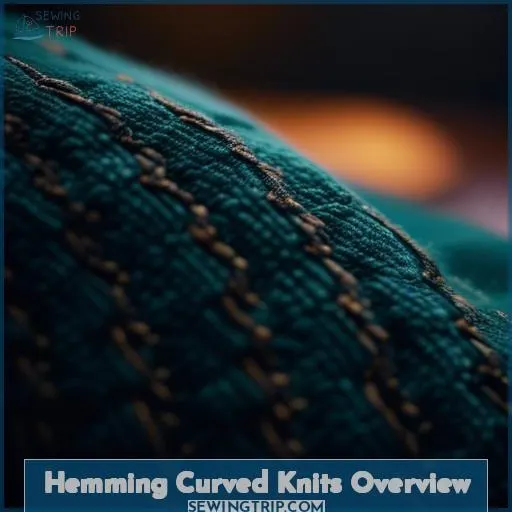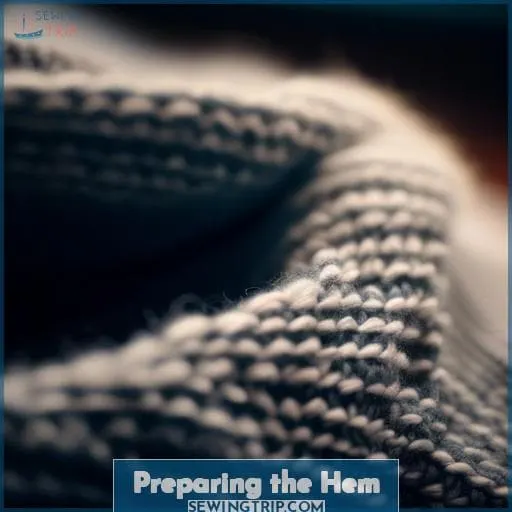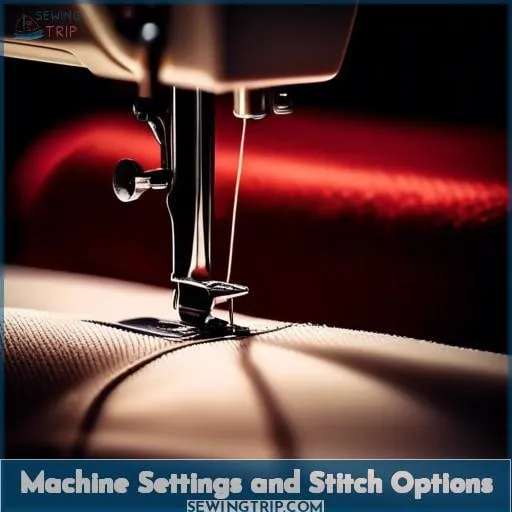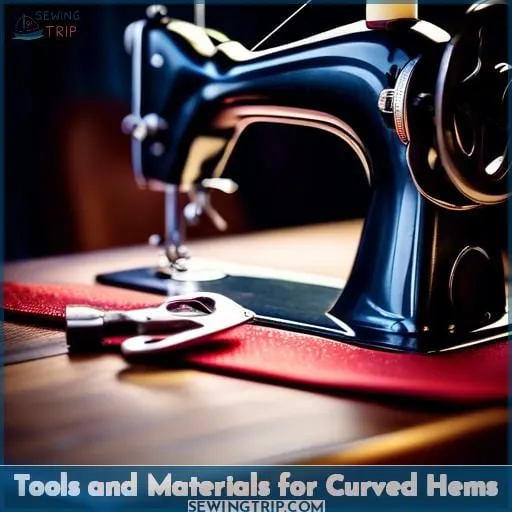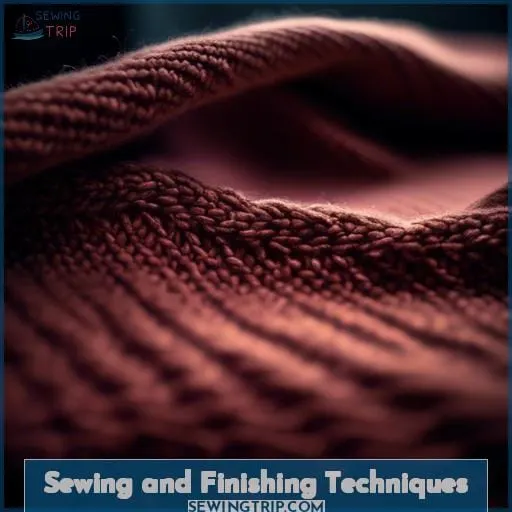This site is supported by our readers. We may earn a commission, at no cost to you, if you purchase through links.
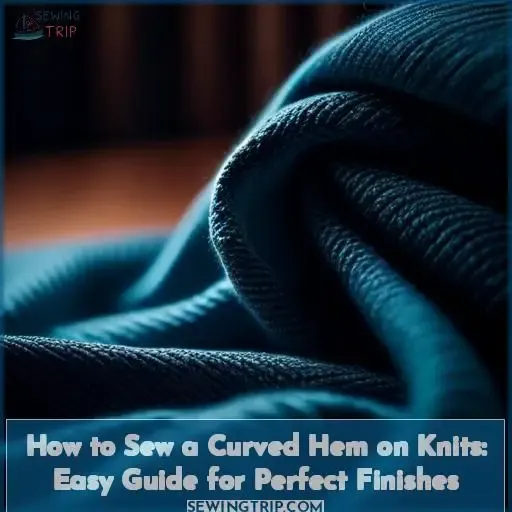
With the right techniques and a touch of patience, you can achieve smooth, professional-looking hems that elevate your homemade garments.
This guide will walk you through the steps to perfect those tricky curved edges, from preparation to the final press, ensuring your knitwear has the polished finish it deserves.
Let’s dive in and master the art of the curved hem.
Table Of Contents
Key Takeaways
- Choose stretchy knit fabric and use knit interfacing for support to ensure the hem maintains its shape and elasticity.
- Utilize a twin needle stitch for a professional finish and a catch stitch for tightly hugging curves, adjusting machine settings to accommodate the knit’s structure.
- Prepare the hem by basting at the desired depth, folding the fabric while stretching or easing for curves, and using the basting stitch as a guide.
- For sewing and finishing, employ a twin needle for neat stitching, switch to a walking foot for better fabric grip, and press gently to avoid damaging the fabric.
Hemming Curved Knits Overview
Ready to tackle that curved hem on your knit project? Let’s dive in!
Hemming knits can be like trying to pat your head and rub your belly at the same time—it requires a bit of coordination and a sprinkle of patience. But fear not! With the right hemming methods, you’ll turn those tricky curves into smooth sailing.
First, cozy up to your fabric. Choosing a knit with just the right amount of stretch is key. Then, knit interfacing becomes your secret weapon, giving your hem the backbone it needs.
A twin needle stitch will glide over your fabric like a figure skater, while a catch stitch will hug those curves tighter than your favorite jeans.
Preparing the Hem
You’re on the brink of mastering curved hems on knits, so let’s tackle the prep work.
Start with a basting stitch at your hem’s depth.
Then fold with finesse, stretching or easing the fabric to match the curve’s demands.
Using a Basting Stitch
After mastering the basics of hemming curved knits, it’s time to dive into using a basting stitch.
This little gem is your secret weapon for taming stretch fabric. Simply set your stitch length longer, and baste at your hem’s desired depth.
This line becomes your folding guide, ensuring your knit hem hugs both concave and convex curves just right.
Folding Techniques for Concave and Convex Curves
When tackling concave and convex curves, think of yourself as a fabric whisperer.
- Use a basting stitch as your roadmap; it’s your best friend in guiding the fold.
- For concave curves, gently stretch the fabric, persuading it to lay flat as a pancake.
- Convex curves? Let them bunch slightly, like gathering clouds, then iron press to smoothness.
Machine Settings and Stitch Options
Selecting the right needle and adjusting your stitch length are crucial steps in achieving a smooth, professional-looking curved hem on knits. Using a stretch stitch versus a zigzag stitch for this delicate task offers distinct benefits.
The stretch stitch is designed to move with the fabric, preventing puckering or distortion along the curved hem. This stitch type creates a subtle, reinforced line that blends seamlessly into the knit material.
In contrast, a zigzag stitch can be more rigid, potentially causing the fabric to pucker or distort as it curves.
Additionally, the stretch stitch typically requires a shorter stitch length compared to a zigzag, which helps maintain the integrity of the knit structure and prevents the fabric from becoming overly perforated.
This attention to detail results in a cleaner, more polished finish on the curved hem.
Choosing the Right Needle and Stitch Length
After mastering the art of folding for those tricky curves, it’s time to dial in your machine settings. Opt for a twin needle to keep things neat, and toggle between a narrow zigzag stitch and a straight stitch with ease.
Think of your needle size and stitch length as your sewing GPS, guiding you to perfection.
Stretch Stitch Vs. Zigzag Stitch
Diving into the zigzag stitch versus stretch stitch debate for your knits’ curved hem? Think of the zigzag finish as your go-to for stretch flexibility, adapting like a chameleon to fabric thickness.
Meanwhile, the stretch stitch is your steadfast friend, ensuring your hem doesn’t play peek-a-boo. Your needle choice and stitch settings are pivotal—like choosing the right dance partner for a flawless performance.
Tools and Materials for Curved Hems
You’ll need a twin needle and hem tape to ace that curved hem on knits. Grab your clips or pins too, because keeping fabric steady is key.
To ace that curved hem on knits, you’ll need a twin needle and hem tape. Keeping the fabric steady is key, so grab your clips or pins as well.
Importance of Twin Needle and Hem Tape
Dive into the art of sewing knits with a curved hem, where the twin needle and hem tape become your secret weapons. Adjusting twin needle tension ensures your stitches sing in harmony, while the strategic hem tape application keeps fabric from playing tricks on you.
Together, they’re the dynamic duo that guarantees those perfect finishes on your beloved knits.
Using Clips or Pins for Securing Fabric
After ensuring your hem tape is in place, it’s time to secure your fabric before the main event—stitching.
- Clips: Great for a quick grip without the ouch of pins.
- Pins: They’re like secret agents, keeping everything undercover and in line.
- Fabric tension: Keep it just right; not too loose, not too tight.
- Seam strength: Ensuring your stitches hold like a promise.
Sewing and Finishing Techniques
Now, let’s tackle the final steps to ensure your curved hems on knits look sharp and professional.
We’ll explore sewing with a twin needle, managing lightweight fabrics, and the crucial last press for that flawless finish.
Sewing With a Twin Needle
Dive into the magic of sewing knits with a twin needle! This wizardry tool doubles your efficiency, creating a professional-looking hem stitch that rivals a cover stitch.
And don’t forget, adjusting the stitch length can be your secret weapon for mastering those tricky curved hems.
Troubleshooting Lightweight Fabrics
Sewing lightweight fabrics can be a challenge due to their delicate nature and tendency to move around during stitching.
Use a guide: Lay down a path of tissue paper under the fabric for stability, providing a reliable foundation for your stitches.
Switch to a walking foot: This type of foot offers additional grip, preventing your fabric from bunching up and creating a more even stitching experience.
Press gently: When pressing your finished piece, use a gentle touch to avoid damaging the delicate fabric. A firm press could potentially distort or damage the material, so it’s important to handle these fabrics with care.
By incorporating these techniques into your sewing process, you can ensure a smoother, more successful experience when working with lightweight, sensitive fabrics.
Final Pressing for a Professional Finish
Sewing a curved hem with a straight stitch on a jade tee is just the beginning. The real magic happens when you press your fabric with an iron. Proper ironing techniques can elevate your project from homemade to haute couture.
Preparation is key. Before you start ironing, make sure to prepare your fabric. Adjust seam allowances and hem width to ensure a professional finish.
With the right pressing tools in hand, you can give your knit masterpiece the final press it deserves.
Prepare your fabric: Make sure your fabric is clean and dry before you start ironing. This will help prevent any water stains or other damage.
Adjust seam allowances: Check the seam allowances on your jade tee. Make sure they are even and flat before you start ironing.
Finesse the hem width: Pay attention to the width of the hem on your jade tee. Use a measuring tape to ensure that it is consistent throughout.
Choose the right setting: Select the appropriate setting on your iron for the fabric you are using. This will help prevent any damage or shrinkage.
Press gently: When ironing, press gently and evenly. Avoid using too much pressure, as this can stretch or distort the fabric.
Use a pressing cloth: If you are ironing a delicate fabric, use a pressing cloth to protect it from direct heat.
Let it cool: After ironing, let the fabric cool before moving it. This will help set the creases and prevent wrinkles.
By following these steps, you can give your knit masterpiece the professional finish it deserves.
Frequently Asked Questions (FAQs)
Can I hem knits without a twin needle?
Hemming knits without a twin needle is possible and there are a few stitch options to consider.
Zigzag stitch: This stitch provides stretch, making it a good choice for hemming knit fabrics. It can be used with a single needle and creates a flexible hem that moves with the fabric.
Stretch stitch: If you’re looking for a stronger hold, consider using a stretch stitch. This stitch is designed to handle the stretch of knit fabrics and provides a more robust finish. It can also be used with a single needle.
In summary, when hemming knits without a twin needle, you can choose between a zigzag stitch for flexibility or a stretch stitch for strength. Both options are suitable for knit fabrics and can be accomplished with a single needle.
How do I prevent hem waviness on knits?
Imagine your knit hem as a tightrope walker; balance is key.
Use a walking foot, stretch stitch, and avoid pulling the fabric.
Like a skilled performer, these steps keep your hem from dancing into waves.
What alternatives exist for hem tape?
Ditch the hem tape and embrace alternatives like fusible web, stitch witchery, or fabric glue for a no-fuss finish.
They’re your secret weapons for sleek, stretchy hems without the bulk or the headache.
How to hem knits without a serger?
To hem knits without a serger, use a stretch or zigzag stitch on your machine.
Employ a twin needle for a professional finish.
Stabilize hems with fusible tape or knit interfacing.
Can I use a straight stitch on knits?
Sure, you can use a straight stitch on knits—just stretch the fabric slightly as you sew to maintain elasticity.
Conclusion
Sewing a curved hem on knits is akin to painting your masterpiece with threads and fabric.
Preparation: The right preparation is key. Ensure you have the necessary tools and supplies.
Understanding Curves: Grasp the concept of sewing curves. This involves adjusting your stitch length and tension, and using the right needle.
Stitch Selection: Choose the right stitch. A narrow zigzag stitch or a lightning bolt stitch are good options for knit fabrics.
Sewing the Curve: Sew the curve slowly and smoothly, maintaining an even stitch length.
Finishing Touches: Once the curve is sewn, trim any excess fabric and finish the raw edge to prevent unraveling.
Embrace the process, and soon, you’ll be crafting smooth, professional-looking hems that elevate your knit projects.

